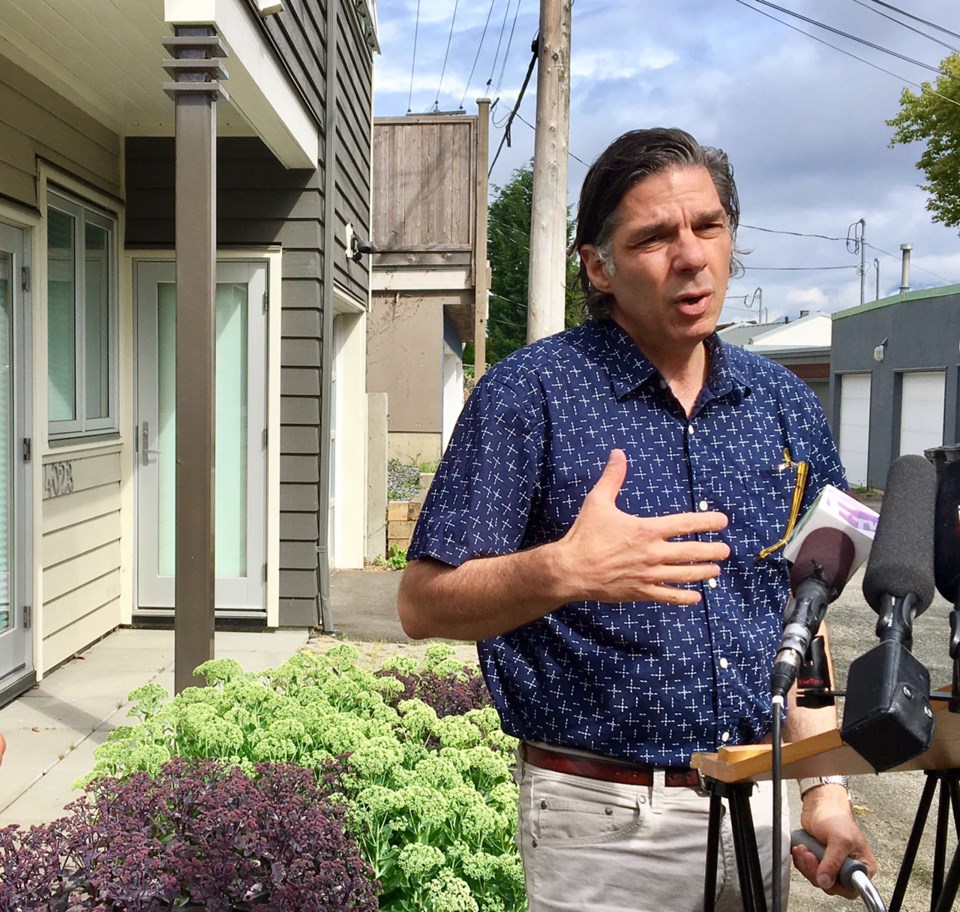The owner of a company that built 150 laneway homes in Vancouver believes proposed zoning changes for single-family neighbourhoods will allow property owners to help solve the city’s affordable housing crisis.
Jake Fry of Smallworks said the proposed changes, which allow for duplexes, coach houses and more laneway homes across the city, offer options for landlords to build additional housing on their properties that can be rented and sold.
“We’re looking at citizens of Vancouver actually helping resolve the problem of housing themselves, and not relying on large developers or intergovernmental agencies,” said Fry at a news conference Thursday in front of a laneway home his company built on Quesnel Drive in Mackenzie Heights. “This is something a homeowner can do that will have an actual significant impact on actually improving the community that they live in.”
Fry attended the news conference with Mayor Gregor Robertson and the city’s chief planner, Gil Kelley, to outline some of the changes that will be reviewed by city council next Tuesday.
The city’s strategy has many facets but protecting approximately 12,000 pre-1940 character homes is at the core of the proposed changes. One key recommendation is to allow owners of those homes to build coach houses and other smaller homes that can be stratified and sold – that’s only if an owner retains the character of the main home on the property.
The move is the city’s answer to preventing property owners from demolishing character homes to build larger homes. In recent years, the West Side of the city has lost older homes to bulldozers. Also, the 2016 census recorded a decline in families and children in the neighbourhoods of Dunbar, Kerrisdale and Arbutus Ridge.
On the East Side, city staff has proposed incentives for homeowners in Mount-Pleasant and Grandview-Woodland, including allowing rental laneway homes, increasing the number of homes on a 33-foot-wide lot from two to three, introducing a new detached form of duplex where a larger home is built at the front and smaller home at the back lane and permitting four-plexes on large lots.
“People do want more options in the low-density neighbourhoods,” the mayor said. “They want low and mid-rise housing options. Certainly, we hear all the time about the need for more laneway [homes], coach houses, townhouses, row houses – forms of housing we’ve only started to introduce in Vancouver recently.”
While the incentives are expected to create more homes for sale, Robertson said the new zoning changes are geared to renters earning $30,000 to $80,000 and couples and families who earn more than $80,000.
Kelley acknowledged the city’s proposed strategy doesn’t restrict property owners from charging whatever they want in rent. But, he added, the new zoning rules – if passed by council – will likely create a lot more housing supply, even if a portion of the 12,000 owners of pre-1940 character homes and owners of 4,800 eligible properties in Grandview-Woodland and Mount Pleasant take advantage of the changes.
“Even if you get one or two per cent of that capacity each year, you’re talking about several thousand units by the time we get a decade or so hence,” he said. “So I think it does add a lot of important supply.”
Fry said the laneway house on Quesnel Drive cost $350,000 to build but didn’t know how much the owner charged for rent. The owner wasn’t home when the Courier knocked on the door Thursday.
The mayor’s director of communications, Katie Robb, told reporters she and her partner recently rented a three-bedroom laneway home off Nanaimo Street for $2,000 per month.
Fry said about 75 per cent of the laneway homes his company built in Vancouver are occupied by relatives of the owners. Typically, he added, it’s the owners’ children.
He’s, however, noticing a new trend.
“What we’ve been seeing more and more of is retired people leaving the workforce, building a laneway house and renting the main house,” he said.
If council approves the proposed changes, it will trigger a public hearing sometime in the fall.
@howellings



